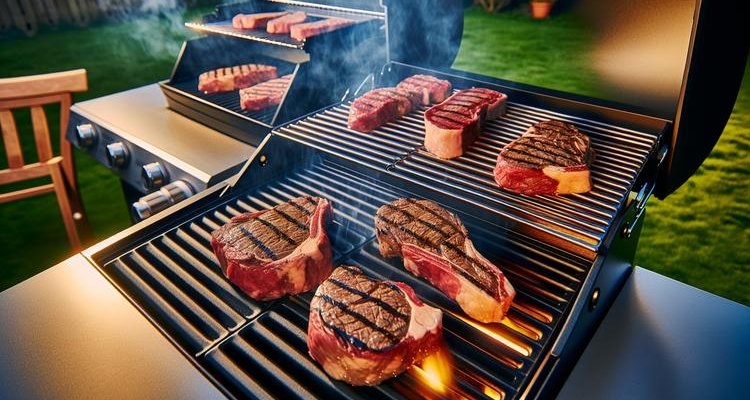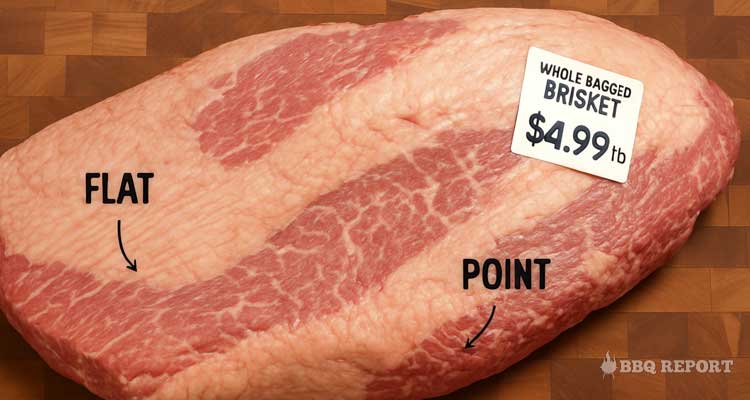
If you’re planning to smoke a brisket for your next family gathering or backyard barbecue, one of the first questions that likely comes to mind is: how much does brisket cost? The price of brisket per pound can vary significantly depending on numerous factors including quality, cut type, where you shop, and even the time of year. This comprehensive guide breaks down everything you need to know about brisket prices in 2025 to help you make an informed purchasing decision.
Current Brisket Prices: What to Expect in 2025
The average price for beef brisket in grocery stores currently ranges from $4 to $5 per pound for standard cuts. However, this is just a starting point, as brisket prices can vary widely depending on the grade, cut, and where you’re purchasing it.
Grocery Store Brisket Prices
When shopping at your local grocery store, here’s what you can typically expect to pay for different types of brisket:
- USDA Select Grade: $2.50 to $3.50 per pound
- USDA Choice Grade: $3.00 to $5.00 per pound
- USDA Prime Grade: $4.00 to $7.00 per pound
- Wagyu Brisket: $8.00 to $15.00 per pound
Different retailers may offer varying prices for similar cuts of brisket. Here’s a breakdown of what you might expect to pay per pound at popular stores:
Brisket Price Comparison Guide 2025
Compare current prices across major retailers to find the best deals on beef brisket in your area.
*Prices are approximate and may vary by location. Last updated: April 2025
According to the USDA’s latest market reports, the average national price per pound of brisket is currently $4.50 per pound, though prices can range from $2.50 to $8.00 per pound depending on location and quality. For wholesale restaurant supply, the average national price per pound of brisket was recently $3.76, representing a 2% month-over-month increase. Toast’s restaurant industry data shows that wholesale restaurant brisket prices have increased 2% month-over-month in 2025.
Understanding Brisket Cuts and How They Affect Price
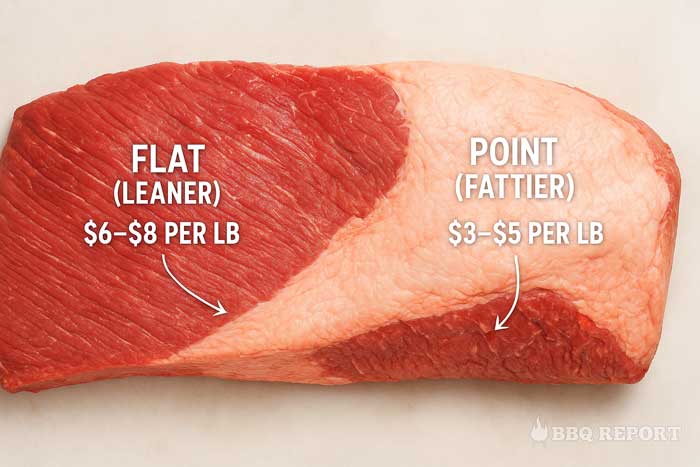
When discussing the cost of a brisket, it’s essential to understand that there are different cuts available, each with its own price point.
Whole Packer Brisket
A whole packer brisket includes both the flat and the point, typically weighing between 10-16 pounds. This is usually the most economical option when looking at price per pound. You can expect to pay between $3-$6 per pound for a choice grade whole packer, making it one of the more affordable cuts of beef per pound despite its overall high ticket price due to weight.
The Flat (First Cut)
The flat is the leaner portion of the brisket with a uniform thickness. It’s often preferred for slicing and presentation. Due to the additional butcher labor involved in separating this cut:
- Typically costs $2-$4 more per pound than a whole packer
- Ranges from $6-$12 per pound depending on grade and store
- Weighs approximately 6-10 pounds on average
The Point (Second Cut)
The point is the fattier, more marbled section of the brisket that’s often used for burnt ends:
- Usually less expensive than the flat if sold separately
- Rich in flavor due to higher fat content
- Less commonly sold on its own in regular grocery stores
Factors That Influence Brisket Prices
Several key factors can affect how much you’ll pay for brisket:
1. Beef Grade
The USDA grade significantly impacts the price of brisket:
- Select Grade: The most affordable option but less marbling and potentially tougher results
- Choice Grade: Good marbling and the most commonly available grade in supermarkets
- Prime Grade: Superior marbling resulting in more tender, flavorful meat at a premium price
- Wagyu/Specialty Breeds: The highest prices but exceptional marbling and eating experience
2. Seasonal Variations
Brisket prices can vary depending on the time of year:
- Summer Grilling Season: Prices typically increase during peak BBQ months (May-September)
- Holiday Periods: Expect higher prices around major holidays when demand spikes
- Winter Months: Often the best time to find deals on brisket
3. Geographic Location
Where you live can have a significant impact on brisket prices:
- Texas and Southern States: Often have more competitive prices due to higher demand and turnover
- Urban Areas: Generally higher prices than rural locations
- Regions with Local Beef Production: May offer better prices directly from producers
4. Supply Chain Factors
Several broader market conditions affect the cost of brisket:
- Weather conditions affecting cattle production
- Feed costs for cattle
- Fuel and transportation costs
- Supply chain disruptions
- Overall beef demand nationally and internationally
Restaurant Brisket Prices vs. Retail
If you’re comparing the cost of cooking your own brisket versus ordering at a restaurant, be prepared for significant price differences. Restaurant brisket prices have climbed substantially in recent years.
Most BBQ restaurants now charge between $20-$40 per pound for brisket, with prices varying by location:
- Budget BBQ Joints: $18-$25 per pound
- Mid-Range BBQ Restaurants: $25-$32 per pound
- Premium BBQ Establishments: $30-$40+ per pound
These high prices reflect not just the raw meat cost but also:
- Labor-intensive smoking process (10-16 hours)
- Significant weight loss during cooking (up to 40%)
- Rising labor and overhead costs
- Restaurant profit margins
How Much Brisket Do You Need?
Understanding how much brisket to buy helps ensure you’re not overspending:
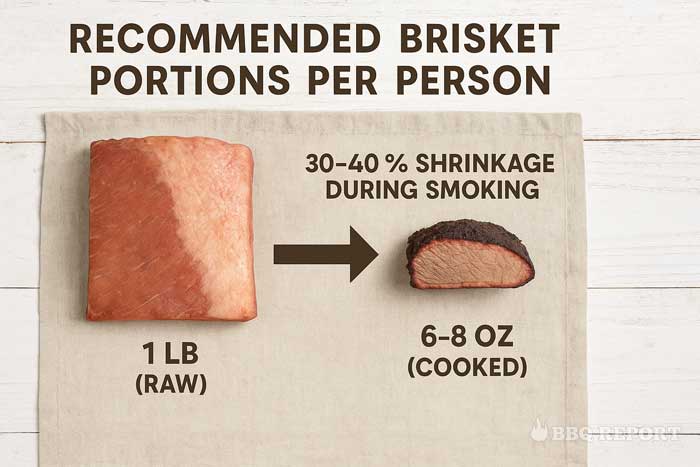
Portion Sizing
For planning purposes:
- Raw brisket: Plan for 0.75-1 pound per person
- Cooked brisket: Expect approximately 0.5 pounds per person after cooking
- For hearty eaters: Consider 1.5 pounds raw per person
- With many sides: 0.5-0.75 pounds raw per person may be sufficient
Weight Loss During Cooking
Brisket shrinks considerably during cooking:
- Expect a 30-40% reduction in weight from raw to cooked
- A 12-pound raw brisket might yield only 7-8 pounds of cooked meat
- Factor this shrinkage into your cost calculations and serving estimates
For example, a ten-pound brisket could potentially feed around 13 to 20 people, assuming the brisket is the main protein accompanied by side dishes.
Where to Find the Best Brisket Prices
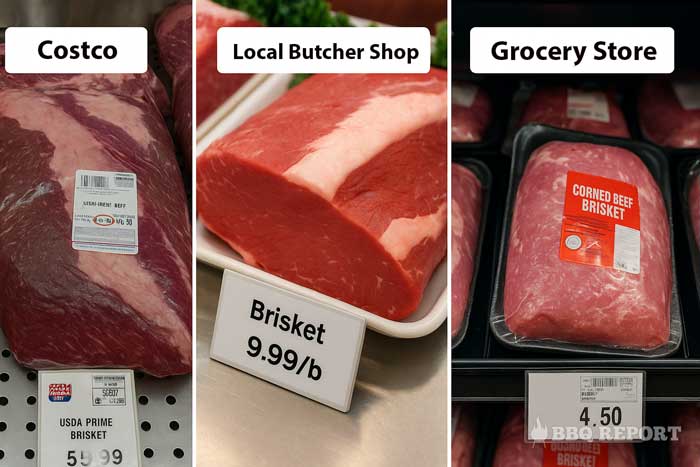
Wholesale Clubs and Big Box Stores
- Costco: Often offers the best combination of quality and price for brisket, with prime grade whole packers frequently available at better prices than choice grade cuts at other retailers
- Sam’s Club: Competitive pricing on choice and prime briskets
- Walmart: Lower prices but potentially lower quality and selection
Local Butchers
- May offer higher prices but better quality and guidance
- Often provide custom trimming and preparation
- Building a relationship can lead to better deals and notifications when prices drop
Online Meat Retailers
- Premium services like Snake River Farms offer high-quality brisket shipped directly to your door
- Prices typically range from $9-$25 per pound depending on grade and specialty
- Convenient but generally more expensive than local options
Direct from Farmers
- Purchasing a quarter or half cow can result in significant savings on brisket and other cuts
- Requires freezer space and upfront investment
- Supports local agriculture
Tips for Saving Money on Brisket
- Watch for Sales: Major grocery stores often discount brisket during holiday weekends and off-season periods
- Buy in Bulk: Consider splitting a large purchase with friends or family
- Explore Less Popular Times: Shop for brisket during winter months when demand is lower
- Utilize the Entire Brisket: Make beef tallow from trimmings, use leftovers for multiple meals
- Choose Whole Packers: Buy the whole packer brisket rather than just the flat for better value per pound
- Compare Prices: Check multiple stores as prices can vary significantly
- Consider Choice Grade: For many cooking applications, especially slow smoking, choice grade offers excellent results at a lower price point than prime
Is Brisket Worth the Cost?
Despite rising prices, brisket remains relatively economical compared to premium steaks and other specialty cuts. Consider that:
- On a per-serving basis, brisket is still more affordable than ribeye, strip steak, or tenderloin
- The flat cut, while more expensive, offers easier preparation and less waste
- The point provides exceptional flavor and can be transformed into multiple dishes
- Leftover brisket can be repurposed for multiple meals, extending its value
Conclusion: Making an Informed Brisket Purchase
The cost of a brisket depends significantly on where you buy it, what grade you select, and what cut you prefer. While prices continue to fluctuate due to market conditions, understanding these variables helps you make the best decision for your budget and needs.
For most home cooks, a choice grade whole packer brisket from a warehouse club like Costco or Sam’s Club offers the best value while still providing excellent results. If you’re cooking for a special occasion, the upgrade to prime grade is often worth the additional cost per pound.
Remember that properly cooked brisket serves many people and can provide multiple meals, making it a worthwhile investment despite the initial cost. With careful shopping and proper preparation, brisket remains one of the most satisfying and economical ways to feed a crowd.
Contents
- Current Brisket Prices: What to Expect in 2025
- Understanding Brisket Cuts and How They Affect Price
- Factors That Influence Brisket Prices
- Restaurant Brisket Prices vs. Retail
- How Much Brisket Do You Need?
- Where to Find the Best Brisket Prices
- Tips for Saving Money on Brisket
- Is Brisket Worth the Cost?
- Conclusion: Making an Informed Brisket Purchase


